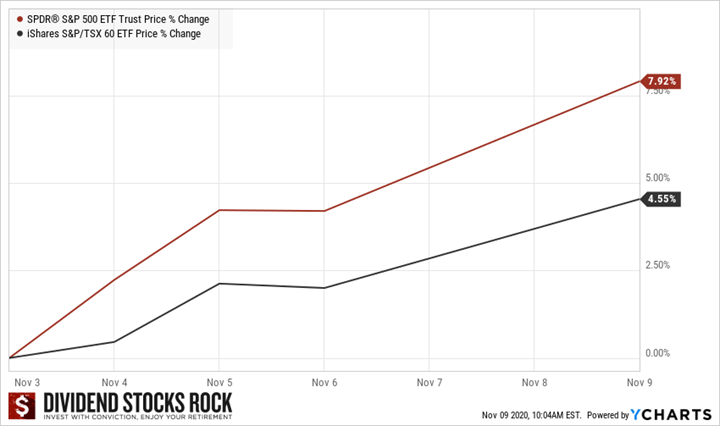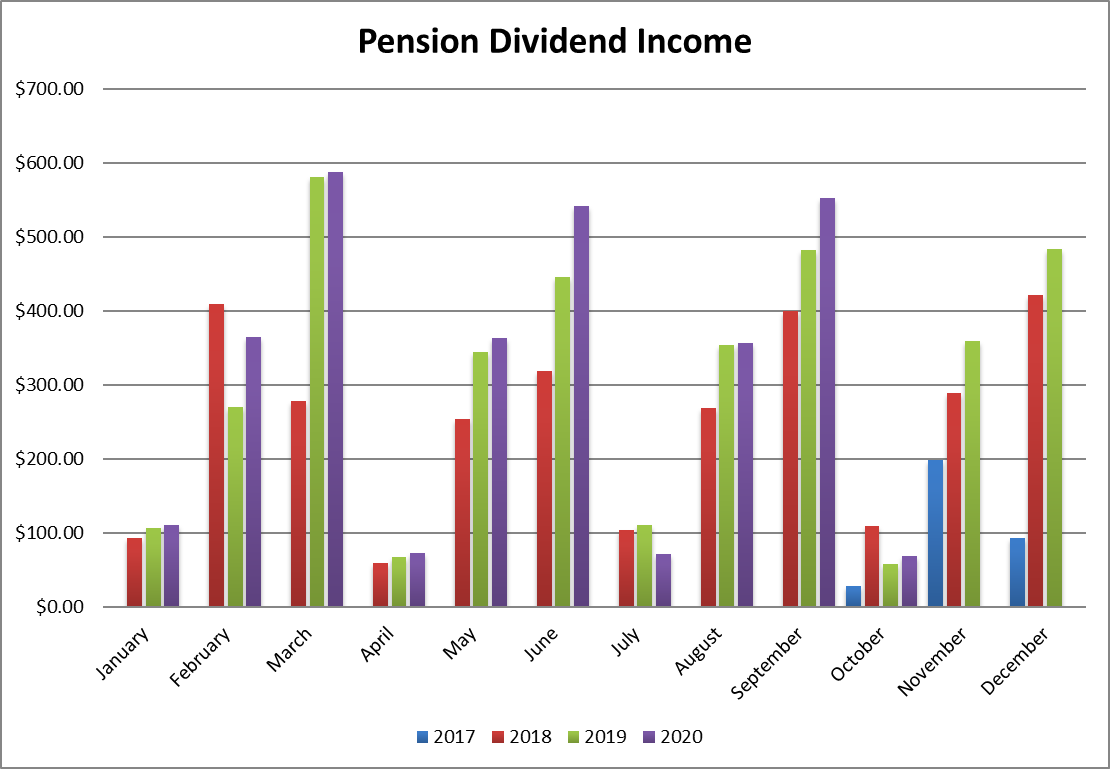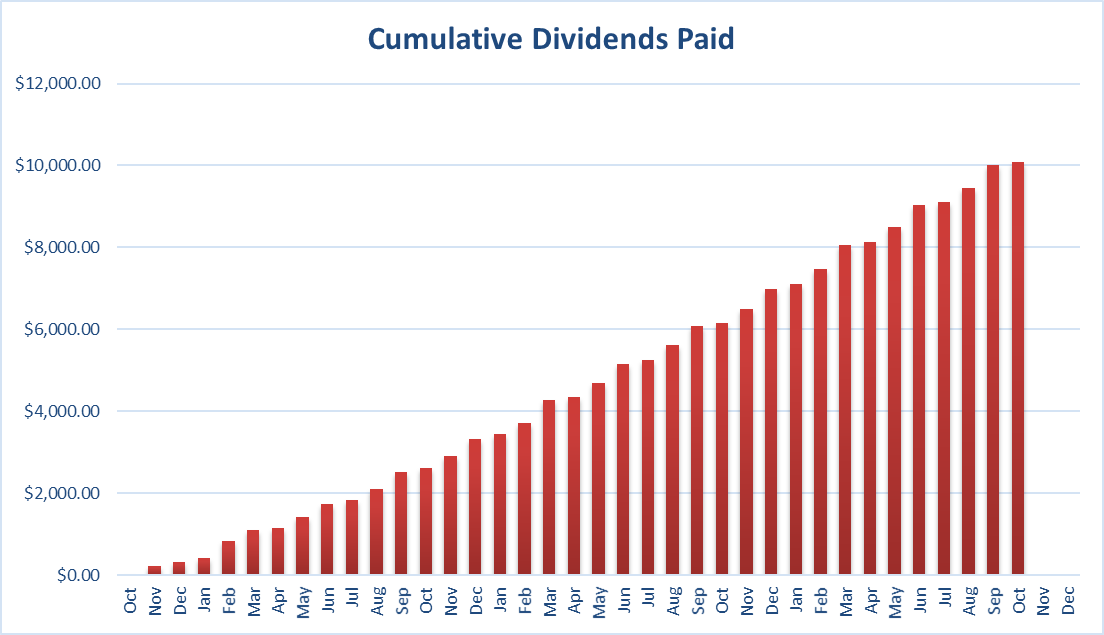 In September of 2017, I received slightly over $100K from my former employer which represented the commuted value of my pension plan. I decided to invest 100% of this money into dividend growth stocks.
In September of 2017, I received slightly over $100K from my former employer which represented the commuted value of my pension plan. I decided to invest 100% of this money into dividend growth stocks.
Each month, I publish my results. I don’t do this to brag. I do this to show you it is possible to build a lasting portfolio during an all-time highly valued market. The market will inevitably go down… as it has lately. But I continue to enjoy cashing consistent and growing dividends despite that negative market action!

You Shall Never Wait
2020 has been a year of waiting for many.
February: I’ll wait to see if the virus gets out of China. It did, and the market crashed!
April: I’ll wait for this spring to see if the virus will survive warm weather. It did, but the market surged back.
June: The Central Banks are printing exorbitant amounts of money, earnings are pitiful, so I’ll wait for September. Nothing much changed in the fall besides the market kept going up.
October: I’ll wait for the election as there is too much uncertainty now. And on November 4th, you woke up not knowing anything… yet. And those who waited patiently for the market to crash after the election… well quite the opposite has happened so far!

Please keep in mind I’m writing this introduction as the market soared on Monday morning. By the time you read this, who knows what will have happened!
This year, I’ve held many webinars. In the first 10 months of the year, I’ve hosted 20 webinars, and 7 of them were private presentations for DSR members only. In all of them, I’ve been asked “Mike, when is the best time to invest? What’s your game plan?”. 20 times, my answer was:
First, know that I am always 100% invested in equity positions.
Second, please know that if you have cash available to invest the best time to invest is now. If you feel uncomfortable with the current situation, invest 1/3 now, then another 1/3 after the next earnings season, and the rest in about 6 months.
In other words: you shall not wait; you should invest now! I deeply believe in this investment mantra and I have never regretted that decision.
I understand how troubling it could be to invest right in the middle of a market crash, or right after the market recovers (while all economic fundamentals are still way down). But the problem isn’t about waiting to seize an opportunity. The problem is that waiting is not a plan.
The problem is that you don’t have a plan
I get that many of you are retired or about to retire. You worked hard for years and constantly made sacrifices to save money. The last thing you want is to lose it. Therefore, you may rather wait and possibly miss opportunities. Because what stays in your account in cash won’t disappear.
I get that you may rather sit and wait to seize the moment. In fact, I can relate to that. But you have been sitting, waiting, and wishing for years and still never invested that money. Do you know why? Do you know why there were not any good opportunities, any sure shots or right moments for you to deploy your liquidity?
Your investment plan starts and stops at “I’ll wait until X….”
But whatever X is and whatever the outcome, you don’t have a plan to act after it happens. I’ve discussed with so many investors telling me they were waiting for the election to invest. When I asked them what they will do on November 4th, they all had the same plan:
Mike, I’ll just look at what happens after Election day and make my decisions.
While the right answer should have been:
If Biden wins, I’ll buy this and that and sell this and that.
If Trump wins, I’ll buy this and that and sell this and that.
After Election Day, there was two possible outcomes. One party must win, and one party must lose. Therefore, if Election Day was so important for your investments, you should have had two plans lined-up.
Now that you have missed this rally, what can you do?
I don’t know if this market rally will continue through the rest of the year. I don’t know if a new President and some good news around a possible vaccine is enough to compensate for the now enormous Government indebtedness and the many bankruptcies that will no doubt come into play in the next few months.
Maybe you’ll get lucky and you’ll get another market crash to buy into, or maybe you won’t.
But we shouldn’t invest on “maybes”, should we?
At the end of August, one of my DSR newsletters was about having an investment game plan for fall. Here’s a short summary:
Step #1: 1/3 in sectors that have not yet recovered (detailed in that newsletter)
Step #2: 1/3 at the end of November so you know the fate of the projected “second wave”.
Step #3: 1/3 after you get earnings for the end of the year (mostly during mid-January to early March).
Now, you have only missed step #1. It’s not too late to get on board! Here’s how you can act now:
Step #1: Identify sectors you want exposure to.
Step #2: Build yourself a buy list (you can use the Mike’s buy list, or our DSR PRO ratings).
Step #3: Use 1/3 of your money to buy your favorite picks.
Step #4: Use another 1/3 to buy other companies from this list after the Jan-Mar earnings season.
Step #5: Invest the rest during the second earnings season of 2021.
In early December, we will also provide you with the top stocks by sector for 2021. This should be enough ideas to get you excited and increase your confidence. The point is to get the ball rolling as soon as possible. The faster you start investing any available funds, the stronger your confidence in your portfolio will be.
Keep in mind that the portfolio I report on monthly was built between September and December 2017. The money was invested at the all-time high market level. To date, my portfolio has never gone back to the original value I invested. That includes the 2018 market crash which happened less than 12 months after I started the portfolio, and the massive market crash of March 2020. Today is always the best time to invest.
Here’s my CDN portfolio now. Numbers are as of November 6th, 2020 (before the bell):
Canadian Portfolio (CAD)
| Company Name | Ticker | Market Value |
| Alimentation Couche-Tard | ATD.B.TO | 7,858.68 |
| Andrew Peller | ADW.A.TO | 6,317.08 |
| National Bank | NA.TO | 5,340.00 |
| Royal Bank | RY.TO | 5,776.20 |
| CAE | CAE.TO | 4,794.00 |
| Enbridge | ENB.TO | 5,976.32 |
| Fortis | FTS.TO | 5,326.20 |
| Intertape Polymer | ITP.TO | 4,764.00 |
| Magna International | MG.TO | 5,051.20 |
| Sylogist | SYZ.V | 4,065.75 |
| Cash | 580.96 | |
| Total | $55,850.39 |
My account shows a variation of +$1,526.05 (+2.8%) since the last income report on October 5th.
Not many Canadian companies have reported their earnings in October. They are always late to the party. Fortis came in late on Oct 30th with modest results as EPS had been hurt by the issuance of $1.2B of common equity in Q4 2019.The capital plan is progressing well with $2.9B spent during the first nine months of 2020. FTS is on plan with its $4.3B CAPEX budget for the year. The Corporation’s five-year capital plan for 2021 to 2025 is $19.6B, up $0.8B from the prior five-year plan. Most importantly, FTS increased its dividend by 6% and forecast a similar annual growth rate through 2025.
Here’s my US portfolio now. Numbers are as of November 6th, 2020 (before the bell):
U.S. Portfolio (USD)
| Company Name | Ticker | Market Value |
| Apple | AAPL | 11,426.88 |
| BlackRock | BLK | 9,354.66 |
| Disney | DIS | 5,713.20 |
| Gentex | GNTX | 7,073.50 |
| Hasbro | HAS | 3,868.60 |
| Lazard | LAZ | 3,811.74 |
| Microsoft | MSFT | 13,397.40 |
| Starbucks | SBUX | 7,702.70 |
| Texas Instruments | TXN | 7,778.00 |
| United Parcel Services | UPS | 6,051.72 |
| VF Corporation | VFC | 4,286.40 |
| Visa | V | 9,882.00 |
| Cash | 397.74 | |
| Total | $90,774.54 |
The US total value account shows a variation of +$5,210.33 (+6%) since the last income report October 5th.
As you might imagine, while my Canadian stocks cruised through October, my US holdings kept me busy with several earnings reports. Here are a few notable earnings.
Apple (AAPL) did better than expected but didn’t post much growth. Revenue breakdown: iPhone, $26.4B; iPad, $6.8B; Mac, all-time high of $9.03B; Wearables, Home and Accessories, $7.9B; Services, all-time high of $14.5B. While those numbers look acceptable given that we are in the middle of a recession, the 29% revenue decrease in China caught investors’ attention. The business did very well everywhere but in China. Let’s hope this trend changes with the possibility of smoother commercial relations between the U.S. and China.
BlackRock (BLK) posted a strong quarter beating on both EPS and revenue growth expectations with double-digit numbers. Assets under management of $7.81T were up 12% Y/Y. $129B of quarterly total net cash inflows vs. $84.2B in the year-ago quarter were led by continued momentum in fixed income and cash management, with positive flows across all regions, investment styles and product types. Notably, more than 50% of long-term flows were driven by clients in Europe and Asia. The appetite for ETFs and new investment products continues to grow and BLK surfs on this tailwind.
Gentex (GNTX) is on its path to recovery as the automobile industry is slowly coming back. The third quarter of 2020 was the second highest sales quarter in Gentex’s history behind only the third quarter of 2019. Light vehicle production in the company’s primary markets is expected to be down 2% for Q4 and 16% for FY2020. The company expects FY2021 revenue will be 15%-20% higher than the estimated revenue for FY2020. In the meantime, GNTX bought back 1.2M share during the quarter at an average cost at $26.93 per share.
Hasbro (HAS) shares dropped sharply on earnings day while the company beat on both EPS and revenue expectations. Revenue increased 9% Y/Y in the U.S. and Canada segment during Q3 to $977M and 7% in the European region to $517M. The e-commerce channel saw revenue soar 50% during the quarter. Revenue from the eOne segment was down 32% to $193.5M. Hasbro’s total gaming category was up 21% to $543.1M for the quarter. Management even confirmed that they expected a strong Holiday season. Hasbro ended the quarter with $1.1B in cash on their balance sheet. I’m holding on to my shares!
Microsoft (MSFT) may have missed the opportunity to buy Tik Tok, but they still managed to post a solid quarter. The company beat on both EPS and revenue growth expectations on top of increasing its dividend by 10%. Productivity and Business Processes were up 11% Y/Y; Intelligent Cloud was up 20%; More Personal Computing was also up 6%. Azure was up 48% Y/Y compared to 50% in FQ4 and 61% in FQ3. Analysts were expecting about 50%. The performance helped server products and cloud services gain 22% on the year. Productivity and Business included the 9% growth of Office Commercial products and cloud revenue. LinkedIn was up 16% and Dynamics 365 was up 38%.
VF Corporation (VFC) beat on both EPS and revenue expectations despite double-digit revenue declines. Active segment revenue decreased 15% including a 10% decrease in Vans® brand revenue; Outdoor segment revenue decreased 24% including a 25% decrease in The North Face® brand revenue; Work segment revenue increased 14% including a 19% increase in Dickies® brand revenue. The company saw strong sales increases in China (+16%). There were also more sales coming from their digital platform with a 44% sales increase. VF headed into the new quarter with inventories down 10% compared with the same period last year. On November 9th, VFC announced the purchase of Supreme for $2.1B. The stock soared on the news.
My entire portfolio updated for Q3 2020
Each quarter, we run an exclusive report for Dividend Stocks Rock (DSR) members who subscribe to our very special additional service called DSR PRO. The PRO report includes a summary of each company’s earnings report for the period. We have been doing this for an entire year now and I wanted to share my own DSR PRO report for this portfolio. You can download the full PDF giving all the information about all my holdings. Results have been updated as of October 2020.

Download my portfolio Q3 2020 report.
Dividend Income: $68.36 CAD (+18% vs October 2019)

October is one of my smallest months in term of dividends. Last year, I only received 57 dollars! This year is marginally better as I increased my position in Andrew Peller earlier in 2020. Therefore, I’m receiving a few bucks more from my favorite winemaker.
Here’s the detail of my dividend payments.
Dividend growth (over the past 12 months):
- Andrew Peller: +41% (I added more shares, not a real dividend increase)
- Gentex: +4.3%
- Currency fluctuation: -1%
Canadian Holdings payouts: $31.53 CAD
- Andrew Peller: $31.53
U.S. Holding payouts: $28.20 USD
- Gentex: $28.20
Total payouts: $68.36 CAD
*I used a USD/CAD conversion rate of 1.306

Since I started this portfolio in September 2017, I have received a total of $10,079.39 CAD in dividends. Keep in mind that this is a “pure dividend growth portfolio” as no capital can be added into this account other than dividends. Therefore, all dividend growth is coming from the stocks and not from any additional capital.
Final Thoughts
As you may note, I haven’t made any moves on UPS or Enbridge (ENB.TO) yet. I may decide to keep Enbridge after their latest results. In early November, management announced that they intend to invest in lower carbon infrastructure like wind and solar power generation, hydrogen and renewable natural gas. Their goal is to reach net zero greenhouse gas emissions by 2050. In the meantime, the dividend is safe and I’m not exposing my portfolio to too much risk. Enbridge represents only 3.5% of this portfolio, so I can afford to wait to make a decision.
UPS is the other stock on my potential sell list. I like the recent stock surge, but I think it’s a bit too much for its long-term potential. Their business could take a serious hit coming from Amazon anytime soon. After making a good profit on this trade, UPS looks like a good candidate for initiating a stop loss.
Cheers,
Mike.
The post You Shall Never Wait to Invest – October Dividend Income Report appeared first on The Dividend Guy Blog.
